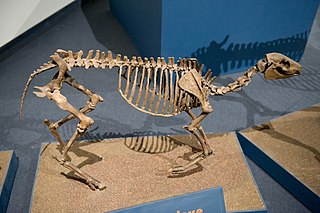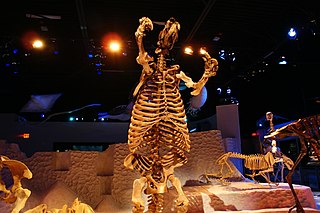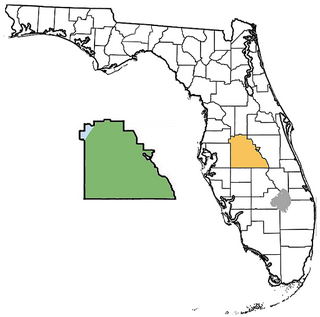
Equidae is the taxonomic family of horses and related animals, including the extant horses, asses, and zebras, and many other species known only from fossils. The family evolved around 50 million years ago from a small, multi-toed ungulate into larger, single-toed animals. All extant species are in the genus Equus, which originated in North America. Equidae belongs to the order Perissodactyla, which includes the extant tapirs and rhinoceros, and several extinct families.

A pika is a small, mountain-dwelling mammal native to Asia and North America. With short limbs, a very round body, an even coat of fur, and no external tail, they resemble their close relative, the rabbit, but with short, rounded ears. The large-eared pika of the Himalayas and nearby mountains lives at elevations of more than 6,000 m (20,000 ft).

In zoology, megafauna are large animals. The most common thresholds to be a megafauna are weighing over 46 kilograms (100 lb) or weighing over a tonne, 1,000 kilograms (2,205 lb). The first of these include many species not popularly thought of as overly large, and being the only few large animals left in a given range/area, such as white-tailed deer, Thomson's gazelle, and red kangaroo.

Merychippus is an extinct proto-horse of the family Equidae that was endemic to North America during the Miocene, 15.97–5.33 million years ago. It had three toes on each foot and is the first horse known to have grazed.

Miohippus is an extinct genus of horse existing longer than most Equidae. It lived in what is now North America from 32 to 25 million years ago, during the late Eocene to late Oligocene. According to the Florida Museum of Natural History, Othniel Charles Marsh first believed Miohippus lived during the Miocene and thus named the genus using this incorrect conclusion. More recent research provides evidence that Miohippus actually lived during the Paleogene period.

Epicyon is a large, extinct, canid genus of the subfamily Borophaginae, native to North America. Epicyon existed for about 15 million years from the Hemingfordian age of the Early Miocene, to the Hemphillian of the Late Miocene. Epicyon is the largest known canid of all time, with the type species reaching 2.4 m (7.9 ft) in length, 90 cm (35 in) in shoulder height and approximately 100–125 kg (220–276 lb) in body mass. The largest known humerus specimen belonged to an individual weighing up to 170 kg (370 lb).

Protohippus is an extinct three-toed genus of horse. It was roughly the size of a modern donkey. Fossil evidence suggests that it lived during the Late Miocene, from about 13.6 Ma to 5.3 Ma.

Pseudhipparion is an extinct genus of three-toed horse endemic to North America during the Miocene. They were herding animals whose diet consisted of C3 plants. Fossils found in Georgia and Florida indicate that it was a lightweight horse, weighing up to 90 pounds. In 2005, fossils were unearthed in Oklahoma. Seven species of Pseudhipparion are known from the fossil record which were very small, following the trend of Bergmann's rule.

Nannippus is an extinct genus of three-toed horse endemic to North America during the Miocene through Pleistocene, about 13.3—1.8 million years ago (Mya), living around 11.5 million years. This ancient species of three-toed horse grew up to 3.5 feet and weighed between 165 pounds to 199 pounds, which was around the same size as a domestic sheep.

Nesodon is a genus of Miocene mammal belonging to the extinct order Notoungulata which inhabited southern South America during the Late Oligocene to Miocene living from 29.0 to 16.3 Ma and existed for approximately 12.7 million years. It had a relatively large size, weighing up to 554 kg (1221 lbs) and reaching 1.5 m in height.

Pediomeryx is an extinct genus of artiodactyl, of the family Dromomerycidae, endemic to North America. It lived during the Late Miocene 10.3—4.9 Ma, existing for approximately 5 million years. Fossils have been recovered from the Midway Site in Florida, the Gray Fossil Site in northeast Tennessee, several sites in Nebraska and Wyoming, Saskatchewan, and Boron, California. They were comparable in size to red deer, with most specimens weighing 100-200 kg but surpassing 400 kg in the case of P. figginsi.

Equini is the only living tribe of the subfamily Equinae, which has lived worldwide since the Hemingfordian stage of the Middle Miocene. It is considered to be a monophyletic clade.

Equinae is a subfamily of the family Equidae, known from the Hemingfordian stage of the Early Miocene onwards. They originated in North America, before dispersing to every continent except Australia and Antarctica. They are thought to be a monophyletic grouping. Members of the subfamily are referred to as equines; the only extant equines are the horses, asses, and zebras of the genus Equus, with two other genera Haringtonhippus and Hippidion becoming extinct at the beginning of the Holocene, around 11-12,000 years ago.

Thinobadistes is an extinct genus of ground sloth of the family Mylodontidae endemic to North America during the Miocene-Pliocene epochs (Hemphillian). It lived from 10.3 to 4.9 mya, existing for approximately 5.4 million years.

Aphelops is an extinct genus of hornless rhinocerotids endemic to North America. It lived from the Middle Miocene to the early Pliocene, during which it was a common component of North American mammalian faunas along with Teleoceras.
Pliometanastes is an extinct genus of ground sloths of the family Megalonychidae endemic to North America during the Late Miocene epoch through very early Pliocene epoch. Its fossils have been found in Costa Rica and across the southern United States from California to Florida.

The Hawthorn Group is a stratigraphic unit that includes several geologic formations of Late Oligocene to Pliocene age in North Florida, United States. It is known for its phosphate rock resources, and for its rich assemblages of Neogene vertebrate fossils. It was originally called the Waldo Formation by L.C. Johnson of the United States Geological Survey in 1887, and later became the Hawthorne Group named for Hawthorne, Florida, where its phosphate-rich rock was quarried and processed for use as fertilizer.

The Polk County paleontological sites are assemblages of Early Miocene to Late Pleistocene vertebrates occurring in Polk County, Florida, United States.
The Alachua Formation is a Miocene geologic formation in Florida. The claystones, sandstones and phosphorites of the formation preserve many fossils of mammals, birds, reptiles and fish, among others megalodon.

The Ash Hollow Formation of the Ogallala Group is a geological formation found in Nebraska and South Dakota. It preserves fossils dating back to the Neogene period. It was named after Ash Hollow, Nebraska and can be seen in Ash Hollow State Historical Park. Ashfall Fossil Beds State Historical Park is within this formation.
















